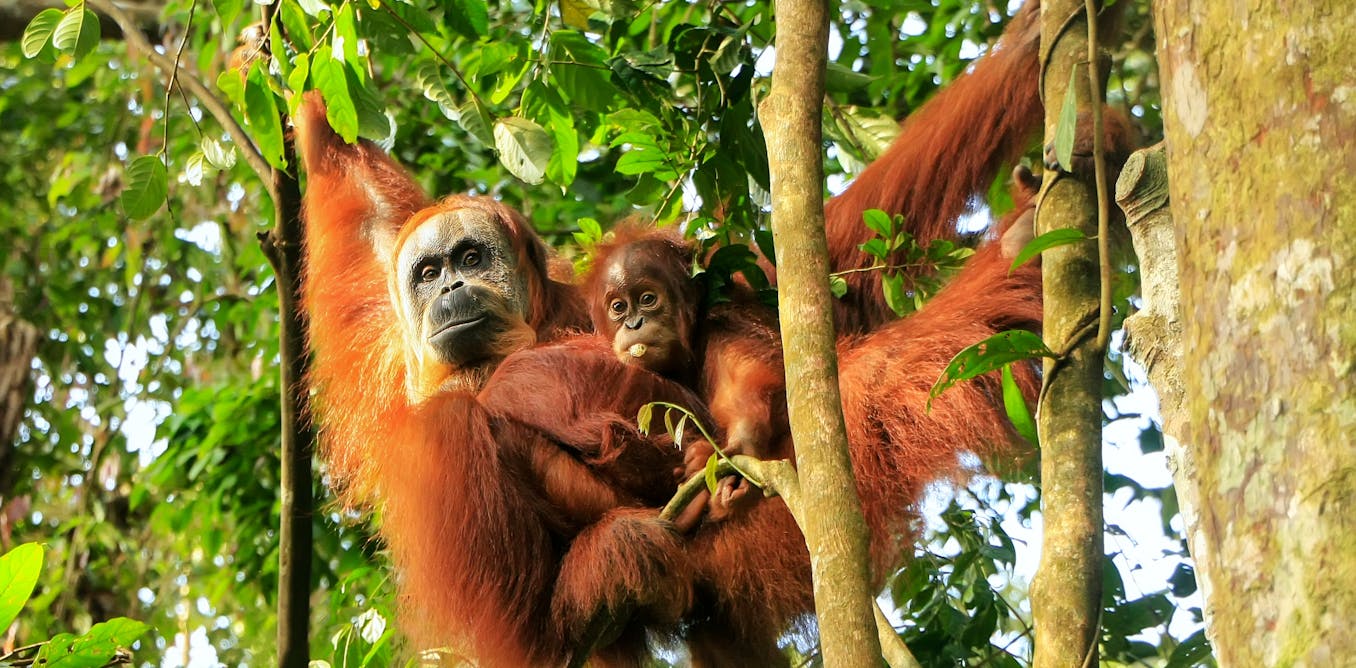In the dense forests of Indonesia, you can hear strange and haunting sounds. At first, these calls may seem like a random collection of noises – but my rhythmic analyses reveal a different story.
Those noises are the calls of Sumatran orangutans (Pongo abelii), used to warn others about the presence of predators. Orangutans belong to our animal family – we’re both great apes. That means we share a common ancestor – a species that lived millions of years ago, from which we both evolved.
Like us, orangutans have hands that can grasp, they use tools and can learn new things. We share about 97% of our DNA with orangutans, which means many parts of our bodies and brains work in similar ways.
That’s why studying orangutans can also help us understand more about how humans evolved, especially when it comes to things like communication, intelligence and the roots of language and rhythm.
Research on orangutan communication conducted by evolutionary psychologist Adriano Lameira and colleagues in 2024 focused on a different species of orangutan, the wild Bornean orangutan (Pongo pygmaeus wurmbii). They looked at a type of vocalisation made only by males, known as the long call, and found that long calls are organised into two levels of rhythmic hierarchy.
This was a groundbreaking discovery, showing that orangutan rhythms are structured in a recursive way. Human language is deeply recursive.
Recursion is when something is built from smaller parts that follow the same pattern. For example, in language, a sentence can contain another sentence inside it. In music, a rhythm can be made of smaller rhythms nested within each other. It’s a way of organising information in layers, where the same structure repeats at different levels.
So, when the two-level rhythmic pattern was discovered in the long calls of male Bornean orangutans, my team wanted to know whether this kind of rhythm was unique to those particular calls, or revealed a deeper part of how orangutans communicate. To find out, we studied the alarm calls of wild female Sumatran orangutans and found something surprising.
Instead of two levels, as had been seen in the Bornean males, this time we found three. This is an even more sophisticated pattern than we expected.
The shared roots of language
Returning to those alarm calls echoing through the Indonesian forest, we can now hear them with new ears. With the help of statistical tools, what sounded like random noise now takes on a clear structure – a rhythmic pattern of calls grouped into regular bouts and repeated in sequences.
Each layer follows a steady rhythm, like the ticking of a metronome.
Until recently, many scientists believed only humans could build layered vocal structures. This belief helped reinforce the idea of a divide between us and other animals.
But our discovery adds to a growing body of research showing this divide may not be so clear-cut. Studies on great apes and other animals such as lemurs, whales and dolphins have revealed they are capable of rhythmic structuring, vocal learning, combining signals and sounds to make new ones, and even using vowels and consonants. These findings suggest the roots of language may lie in shared evolutionary mechanisms.
Human language is unique in many ways. But it probably did not appear suddenly. Even the most striking traits in life evolve by reshaping what already exists, through the slow work of variation and natural selection. Our work suggests the brain systems needed to build recursive patterns were present in our ancestors millions of years ago.
The evolution of language
We wanted to take our investigation a step further and ask why recursive patterns evolved. So, we designed an experiment in which wild orangutans were exposed to different predator models, some posing a more realistic threat than others.
This involved a person walking on all fours under different-coloured blankets. One had tiger stripes (tigers are orangutan predators). The other blankets were blue, white or multi-coloured.
We found that more structured, regular and faster orangutan alarm sequences were made in response to tiger stripes. When the predator seemed less convincing, the vocalisations lost that regularity and slowed down. So, rhythm may help listeners gauge the seriousness of a situation.
These patterns in orangutan calls give us some important hints about how language might have started. But it’s possible that other animals have similar ways of communicating that we haven’t discovered yet. To really understand how things like evolution, social life and the environment shape these interesting communication skills, we need to keep studying many different animals.
Perhaps the most surprising lesson is this: complexity doesn’t always need words. The rhythms, patterns and structures we have uncovered in orangutan alarms remind us that meaningful communication can emerge in many forms – and that the roots of our language may lie not just in what is said, but how it is expressed.

The post “What the hidden rhythms of orangutan calls can tell us about language” by Chiara De Gregorio, Post Doctoral Research Fellow, University of Warwick was published on 05/27/2025 by theconversation.com


































Leave a Reply